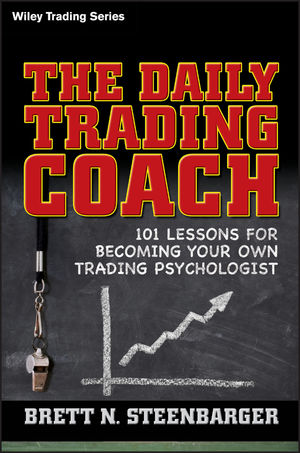The Daily Trading Coach: 101 Lessons for Becoming Your Own Trading PsychologistISBN: 978-0-470-39856-2
Hardcover
368 pages
March 2009
 |
||||||
Preface xiii
Acknowledgments xvii
Introduction 1
Chapter 1 Change: The Process and the Practice 3
Lesson 1: Draw on Emotion to Become a Change Agent 4
Lesson 2: Psychological Visibility and Your Relationship with Your Trading Coach 7
Lesson 3: Make Friends with Your Weakness 9
Lesson 4: Change Your Environment, Change Yourself 11
Lesson 5: Transform Emotion by Trace-Formation 14
Lesson 6: Find the Right Mirrors 17
Lesson 7: Change Our Focus 20
Lesson 8: Create Scripts for Life Change 23
Lesson 9: How to Build Your Self-Confidence 25
Lesson 10: Five Best Practices for Effecting and Sustaining Change 29
Resources 32
Chapter 2 Stress and Distress: Creative Coping for Traders 33
Lesson 11: Understanding Stress 33
Lesson 12: Antidotes for Toxic Trading Assumptions 37
Lesson 13: What Causes the Distress That Interferes with Trading Decisions? 40
Lesson 14: Keep a Psychological Journal 43
Lesson 15: Pressing: When You Try Too Hard to Make Money 45
Lesson 16: When You’re Ready to Hang It Up 48
Lesson 17: What to Do When Fear Takes Over 51
Lesson 18: Performance Anxiety: The Most Common Trading Problem 54
Lesson 19: Square Pegs and Round Holes 58
Lesson 20: Volatility of Markets and Volatility of Mood 61
Resources 64
Chapter 3 Psychological Well-Being: Enhancing Trading Experience 67
Lesson 21: The Importance of Feeling Good 67
Lesson 22: Build Your Happiness 71
Lesson 23: Get into the Zone 73
Lesson 24: Trade with Energy 77
Lesson 25: Intention and Greatness: Exercise the Brain through Play 79
Lesson 26: Cultivate the Quiet Mind 83
Lesson 27: Build Emotional Resilience 86
Lesson 28: Integrity and Doing the Right Thing 89
Lesson 29: Maximize Confidence and Stay with Your Trades 91
Lesson 30: Coping—Turn Stress into Well-Being 95
Resources 97
Chapter 4 Steps toward Self-Improvement: The Coaching Process 99
Lesson 31: Self-Monitor by Keeping a Trading Journal 99
Lesson 32: Recognize Your Patterns 103
Lesson 33: Establish Costs and Benefits to Patterns 106
Lesson 34: Set Effective Goals 109
Lesson 35: Build on Your Best: Maintain a Solution Focus 111
Lesson 36: Disrupt Old Problem Patterns 114
Lesson 37: Build Your Consistency by Becoming Rule-Governed 118
Lesson 38: Relapse and Repetition 121
Lesson 39: Create a Safe Environment for Change 123
Lesson 40: Use Imagery to Advance the Change Process 126
Resources 130
Chapter 5 Breaking Old Patterns: Psychodynamic Frameworks for Self-Coaching 131
Lesson 41: Psychodynamics: Escape the Gravity of Past Relationships 132
Lesson 42: Crystallize Our Repetitive Patterns 135
Lesson 43: Challenge Our Defenses 138
Lesson 44: Once Again, with Feeling: Get Distance from Your Problem Patterns 141
Lesson 45: Make the Most Out of Your Coaching Relationship 144
Lesson 46: Find Positive Trading Relationships 147
Lesson 47: Tolerate Discomfort 150
Lesson 48: Master Transference 153
Lesson 49: The Power of Discrepancy 156
Lesson 50: Working Through 158
Resources 161
Chapter 6 Remapping the Mind: Cognitive Approaches to Self-Coaching 163
Lesson 51: Schemas of the Mind 164
Lesson 52: Use Feeling to Understand Your Thinking 167
Lesson 53: Learn from Your Worst Trades 170
Lesson 54: Use a Journal to Restructure Our Thinking 172
Lesson 55: Disrupt Negative Thought Patterns 176
Lesson 56: Reframe Negative Thought Patterns 179
Lesson 57: Use Intensive Guided Imagery to Change Thought Patterns 182
Lesson 58: Challenge Negative Thought Patterns with the Cognitive Journal 185
Lesson 59: Conduct Cognitive Experiments to Create Change 188
Lesson 60: Build Positive Thinking 190
Resources 193
Chapter 7 Learning New Action Patterns: Behavioral Approaches to Self-Coaching 195
Lesson 61: Understand Your Contingencies 196
Lesson 62: Identify Subtle Contingencies 199
Lesson 63: Harness the Power of Social Learning 201
Lesson 64: Shape Your Trading Behaviors 204
Lesson 65: The Conditioning of Markets 207
Lesson 66: The Power of Incompatibility 211
Lesson 67: Build on Positive Associations 214
Lesson 68: Exposure: A Powerful and Flexible Behavioral Method 217
Lesson 69: Extend Exposure Work to Build Skills 220
Lesson 70: A Behavioral Framework for Dealing with Worry 223
Resources 226
Chapter 8 Coaching Your Trading Business 227
Lesson 71: The Importance of Startup Capital 227
Lesson 72: Plan Your Trading Business 231
Lesson 73: Diversify Your Trading Business 233
Lesson 74: Track Your Trading Results 236
Lesson 75: Advanced Scorekeeping for Your Trading Business 240
Lesson 76: Track the Correlations of Your Returns 244
Lesson 77: Calibrate Your Risk and Reward 248
Lesson 78: The Importance of Execution in Trading 250
Lesson 79: Think in Themes—Generating Good Trading Ideas 254
Lesson 80: Manage the Trade 257
Resources 259
Chapter 9 Lessons from Trading Professionals: Resources and Perspectives on Self-Coaching 261
Lesson 81: Leverage Core Competencies and Cultivate Creativity 261
Lesson 82: I Alone Am Responsible 264
Lesson 83: Cultivate Self-Awareness 271
Lesson 84: Mentor Yourself for Success 275
Lesson 85: Keep Detailed Records 279
Lesson 86: Learn to Be Fallible 283
Lesson 87: The Power of Research 286
Lesson 88: Attitudes and Goals, the Building Blocks of Success 290
Lesson 89: A View from the Trading Firms 295
Lesson 90: Use Data to Improve Trading Performance 300
Resources 305
Chapter 10 Looking for the Edge: Finding Historical Patterns in Markets 307
Lesson 91: Use Historical Patterns in Trading 308
Lesson 92: Frame Good Hypotheses with the Right Data 310
Lesson 93: Excel Basics 313
Lesson 94: Visualize Your Data 317
Lesson 95: Create Your Independent and Dependent Variables 320
Lesson 96: Conduct Your Historical Investigations 324
Lesson 97: Code the Data 327
Lesson 98: Examine Context 329
Lesson 99: Filter Data 332
Lesson 100: Make Use of Your Findings 334
Resources 336
Conclusion 339
Lesson 101: Find Your Path 339
For More on Self-Coaching 341
About the Author 343
Index 345



